Report on Value Chain Analysis of Telstra Corporation Limited
VerifiedAdded on 2021/06/18
|18
|5047
|605
Report
AI Summary
This report offers a comprehensive value chain analysis of Telstra Corporation Limited, a leading telecommunications company in Australia. The study applies Michael Porter's value chain framework to assess Telstra's primary and support activities. It examines inbound logistics, operations, outbound logistics, marketing and sales, and service, highlighting how Telstra leverages these activities to create customer value and gain a competitive advantage. The report details Telstra's innovative solutions in supply chain management, including its partnership with IBM, and analyzes the company's operational strategies, particularly its Integrated Operations Management. Furthermore, the report considers Porter's Five Forces to evaluate Telstra's competitive environment. The analysis identifies key areas for optimization and sharing within the value chain, providing insights into Telstra's strategic approach to maintaining and enhancing its market position. The report underscores the importance of customer satisfaction, technological advancements, and effective marketing in Telstra's success.
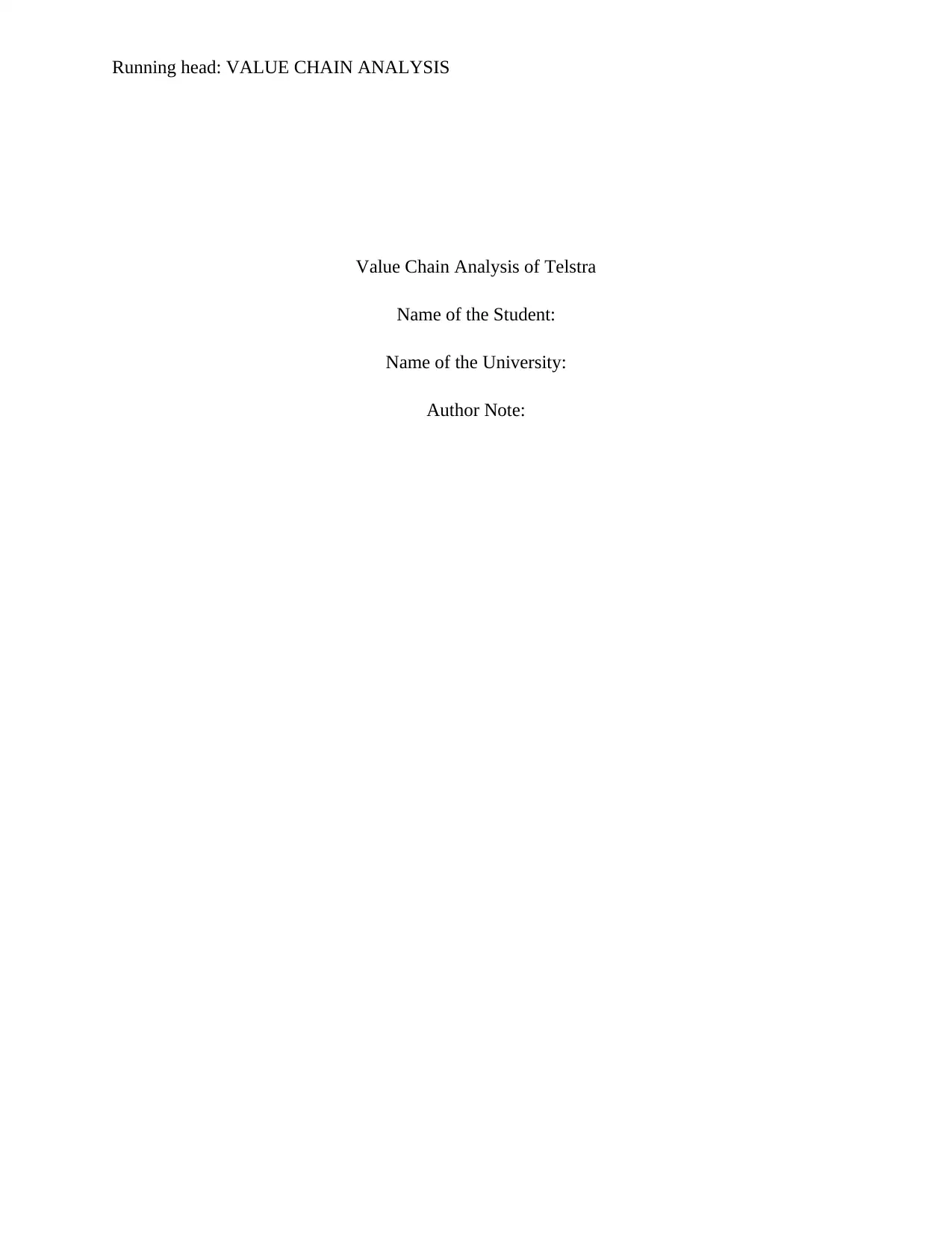
Running head: VALUE CHAIN ANALYSIS
Value Chain Analysis of Telstra
Name of the Student:
Name of the University:
Author Note:
Value Chain Analysis of Telstra
Name of the Student:
Name of the University:
Author Note:
Paraphrase This Document
Need a fresh take? Get an instant paraphrase of this document with our AI Paraphraser
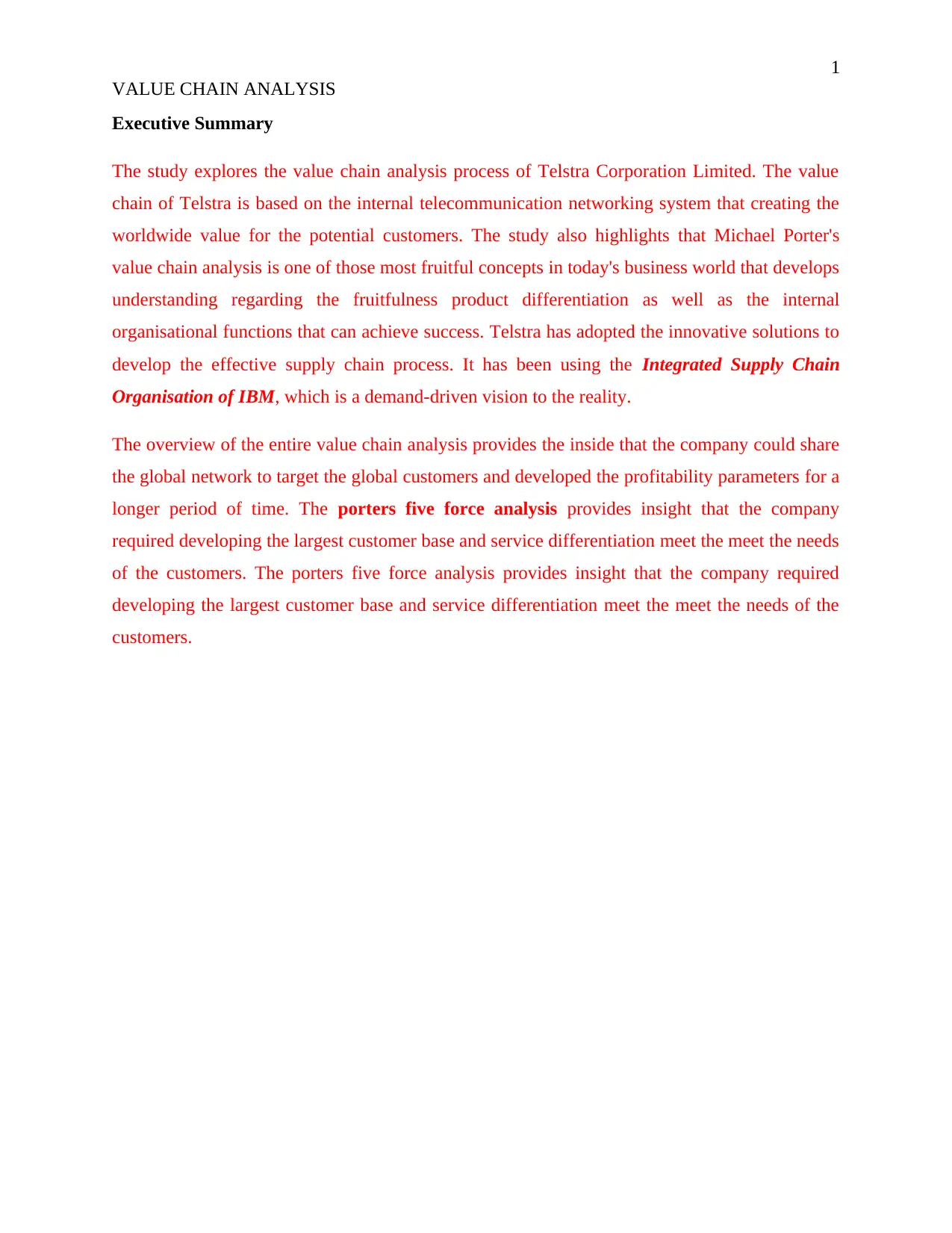
1
VALUE CHAIN ANALYSIS
Executive Summary
The study explores the value chain analysis process of Telstra Corporation Limited. The value
chain of Telstra is based on the internal telecommunication networking system that creating the
worldwide value for the potential customers. The study also highlights that Michael Porter's
value chain analysis is one of those most fruitful concepts in today's business world that develops
understanding regarding the fruitfulness product differentiation as well as the internal
organisational functions that can achieve success. Telstra has adopted the innovative solutions to
develop the effective supply chain process. It has been using the Integrated Supply Chain
Organisation of IBM, which is a demand-driven vision to the reality.
The overview of the entire value chain analysis provides the inside that the company could share
the global network to target the global customers and developed the profitability parameters for a
longer period of time. The porters five force analysis provides insight that the company
required developing the largest customer base and service differentiation meet the meet the needs
of the customers. The porters five force analysis provides insight that the company required
developing the largest customer base and service differentiation meet the meet the needs of the
customers.
VALUE CHAIN ANALYSIS
Executive Summary
The study explores the value chain analysis process of Telstra Corporation Limited. The value
chain of Telstra is based on the internal telecommunication networking system that creating the
worldwide value for the potential customers. The study also highlights that Michael Porter's
value chain analysis is one of those most fruitful concepts in today's business world that develops
understanding regarding the fruitfulness product differentiation as well as the internal
organisational functions that can achieve success. Telstra has adopted the innovative solutions to
develop the effective supply chain process. It has been using the Integrated Supply Chain
Organisation of IBM, which is a demand-driven vision to the reality.
The overview of the entire value chain analysis provides the inside that the company could share
the global network to target the global customers and developed the profitability parameters for a
longer period of time. The porters five force analysis provides insight that the company
required developing the largest customer base and service differentiation meet the meet the needs
of the customers. The porters five force analysis provides insight that the company required
developing the largest customer base and service differentiation meet the meet the needs of the
customers.
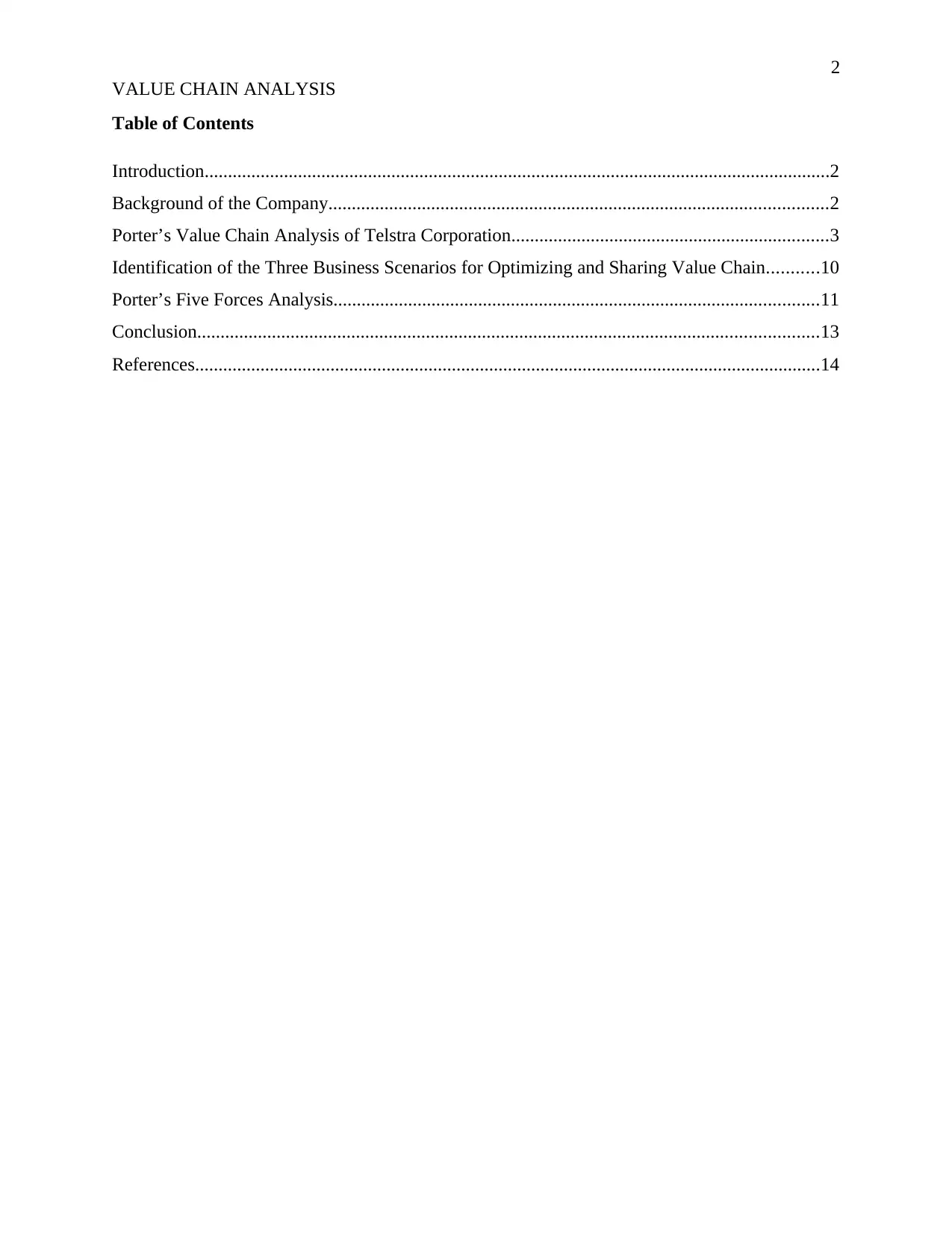
2
VALUE CHAIN ANALYSIS
Table of Contents
Introduction......................................................................................................................................2
Background of the Company...........................................................................................................2
Porter’s Value Chain Analysis of Telstra Corporation....................................................................3
Identification of the Three Business Scenarios for Optimizing and Sharing Value Chain...........10
Porter’s Five Forces Analysis........................................................................................................11
Conclusion.....................................................................................................................................13
References......................................................................................................................................14
VALUE CHAIN ANALYSIS
Table of Contents
Introduction......................................................................................................................................2
Background of the Company...........................................................................................................2
Porter’s Value Chain Analysis of Telstra Corporation....................................................................3
Identification of the Three Business Scenarios for Optimizing and Sharing Value Chain...........10
Porter’s Five Forces Analysis........................................................................................................11
Conclusion.....................................................................................................................................13
References......................................................................................................................................14
⊘ This is a preview!⊘
Do you want full access?
Subscribe today to unlock all pages.

Trusted by 1+ million students worldwide
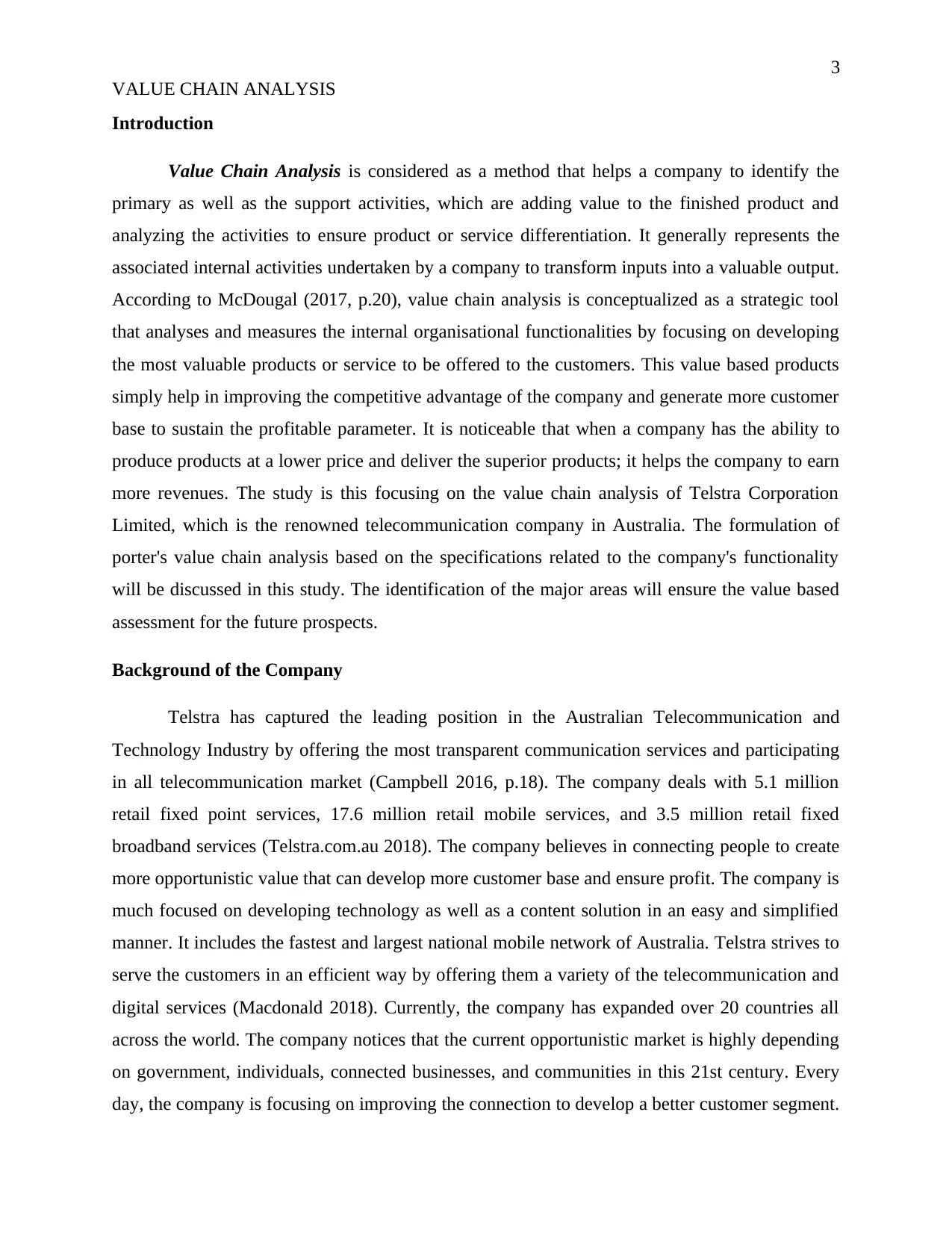
3
VALUE CHAIN ANALYSIS
Introduction
Value Chain Analysis is considered as a method that helps a company to identify the
primary as well as the support activities, which are adding value to the finished product and
analyzing the activities to ensure product or service differentiation. It generally represents the
associated internal activities undertaken by a company to transform inputs into a valuable output.
According to McDougal (2017, p.20), value chain analysis is conceptualized as a strategic tool
that analyses and measures the internal organisational functionalities by focusing on developing
the most valuable products or service to be offered to the customers. This value based products
simply help in improving the competitive advantage of the company and generate more customer
base to sustain the profitable parameter. It is noticeable that when a company has the ability to
produce products at a lower price and deliver the superior products; it helps the company to earn
more revenues. The study is this focusing on the value chain analysis of Telstra Corporation
Limited, which is the renowned telecommunication company in Australia. The formulation of
porter's value chain analysis based on the specifications related to the company's functionality
will be discussed in this study. The identification of the major areas will ensure the value based
assessment for the future prospects.
Background of the Company
Telstra has captured the leading position in the Australian Telecommunication and
Technology Industry by offering the most transparent communication services and participating
in all telecommunication market (Campbell 2016, p.18). The company deals with 5.1 million
retail fixed point services, 17.6 million retail mobile services, and 3.5 million retail fixed
broadband services (Telstra.com.au 2018). The company believes in connecting people to create
more opportunistic value that can develop more customer base and ensure profit. The company is
much focused on developing technology as well as a content solution in an easy and simplified
manner. It includes the fastest and largest national mobile network of Australia. Telstra strives to
serve the customers in an efficient way by offering them a variety of the telecommunication and
digital services (Macdonald 2018). Currently, the company has expanded over 20 countries all
across the world. The company notices that the current opportunistic market is highly depending
on government, individuals, connected businesses, and communities in this 21st century. Every
day, the company is focusing on improving the connection to develop a better customer segment.
VALUE CHAIN ANALYSIS
Introduction
Value Chain Analysis is considered as a method that helps a company to identify the
primary as well as the support activities, which are adding value to the finished product and
analyzing the activities to ensure product or service differentiation. It generally represents the
associated internal activities undertaken by a company to transform inputs into a valuable output.
According to McDougal (2017, p.20), value chain analysis is conceptualized as a strategic tool
that analyses and measures the internal organisational functionalities by focusing on developing
the most valuable products or service to be offered to the customers. This value based products
simply help in improving the competitive advantage of the company and generate more customer
base to sustain the profitable parameter. It is noticeable that when a company has the ability to
produce products at a lower price and deliver the superior products; it helps the company to earn
more revenues. The study is this focusing on the value chain analysis of Telstra Corporation
Limited, which is the renowned telecommunication company in Australia. The formulation of
porter's value chain analysis based on the specifications related to the company's functionality
will be discussed in this study. The identification of the major areas will ensure the value based
assessment for the future prospects.
Background of the Company
Telstra has captured the leading position in the Australian Telecommunication and
Technology Industry by offering the most transparent communication services and participating
in all telecommunication market (Campbell 2016, p.18). The company deals with 5.1 million
retail fixed point services, 17.6 million retail mobile services, and 3.5 million retail fixed
broadband services (Telstra.com.au 2018). The company believes in connecting people to create
more opportunistic value that can develop more customer base and ensure profit. The company is
much focused on developing technology as well as a content solution in an easy and simplified
manner. It includes the fastest and largest national mobile network of Australia. Telstra strives to
serve the customers in an efficient way by offering them a variety of the telecommunication and
digital services (Macdonald 2018). Currently, the company has expanded over 20 countries all
across the world. The company notices that the current opportunistic market is highly depending
on government, individuals, connected businesses, and communities in this 21st century. Every
day, the company is focusing on improving the connection to develop a better customer segment.
Paraphrase This Document
Need a fresh take? Get an instant paraphrase of this document with our AI Paraphraser
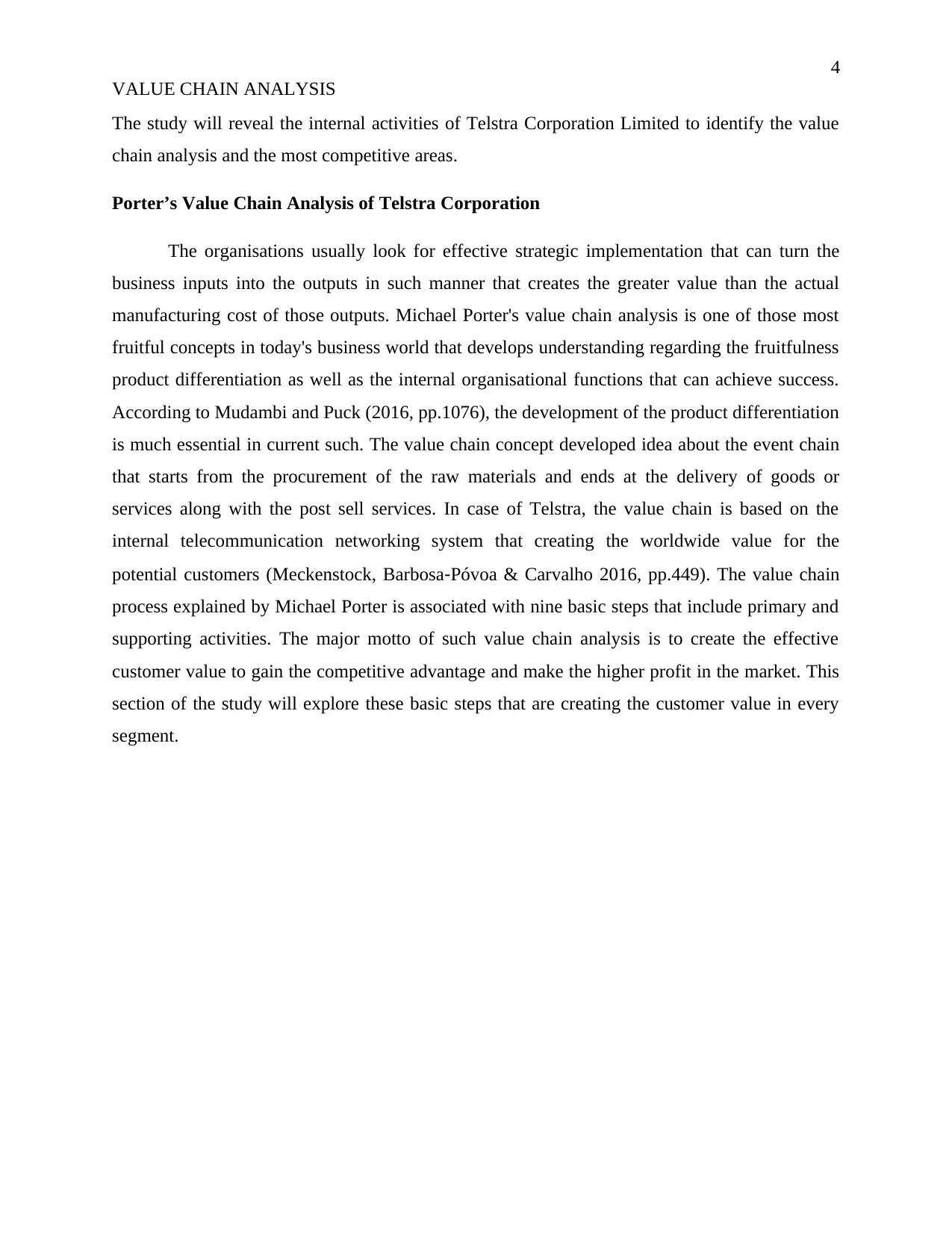
4
VALUE CHAIN ANALYSIS
The study will reveal the internal activities of Telstra Corporation Limited to identify the value
chain analysis and the most competitive areas.
Porter’s Value Chain Analysis of Telstra Corporation
The organisations usually look for effective strategic implementation that can turn the
business inputs into the outputs in such manner that creates the greater value than the actual
manufacturing cost of those outputs. Michael Porter's value chain analysis is one of those most
fruitful concepts in today's business world that develops understanding regarding the fruitfulness
product differentiation as well as the internal organisational functions that can achieve success.
According to Mudambi and Puck (2016, pp.1076), the development of the product differentiation
is much essential in current such. The value chain concept developed idea about the event chain
that starts from the procurement of the raw materials and ends at the delivery of goods or
services along with the post sell services. In case of Telstra, the value chain is based on the
internal telecommunication networking system that creating the worldwide value for the
potential customers (Meckenstock, Barbosa‐Póvoa & Carvalho 2016, pp.449). The value chain
process explained by Michael Porter is associated with nine basic steps that include primary and
supporting activities. The major motto of such value chain analysis is to create the effective
customer value to gain the competitive advantage and make the higher profit in the market. This
section of the study will explore these basic steps that are creating the customer value in every
segment.
VALUE CHAIN ANALYSIS
The study will reveal the internal activities of Telstra Corporation Limited to identify the value
chain analysis and the most competitive areas.
Porter’s Value Chain Analysis of Telstra Corporation
The organisations usually look for effective strategic implementation that can turn the
business inputs into the outputs in such manner that creates the greater value than the actual
manufacturing cost of those outputs. Michael Porter's value chain analysis is one of those most
fruitful concepts in today's business world that develops understanding regarding the fruitfulness
product differentiation as well as the internal organisational functions that can achieve success.
According to Mudambi and Puck (2016, pp.1076), the development of the product differentiation
is much essential in current such. The value chain concept developed idea about the event chain
that starts from the procurement of the raw materials and ends at the delivery of goods or
services along with the post sell services. In case of Telstra, the value chain is based on the
internal telecommunication networking system that creating the worldwide value for the
potential customers (Meckenstock, Barbosa‐Póvoa & Carvalho 2016, pp.449). The value chain
process explained by Michael Porter is associated with nine basic steps that include primary and
supporting activities. The major motto of such value chain analysis is to create the effective
customer value to gain the competitive advantage and make the higher profit in the market. This
section of the study will explore these basic steps that are creating the customer value in every
segment.
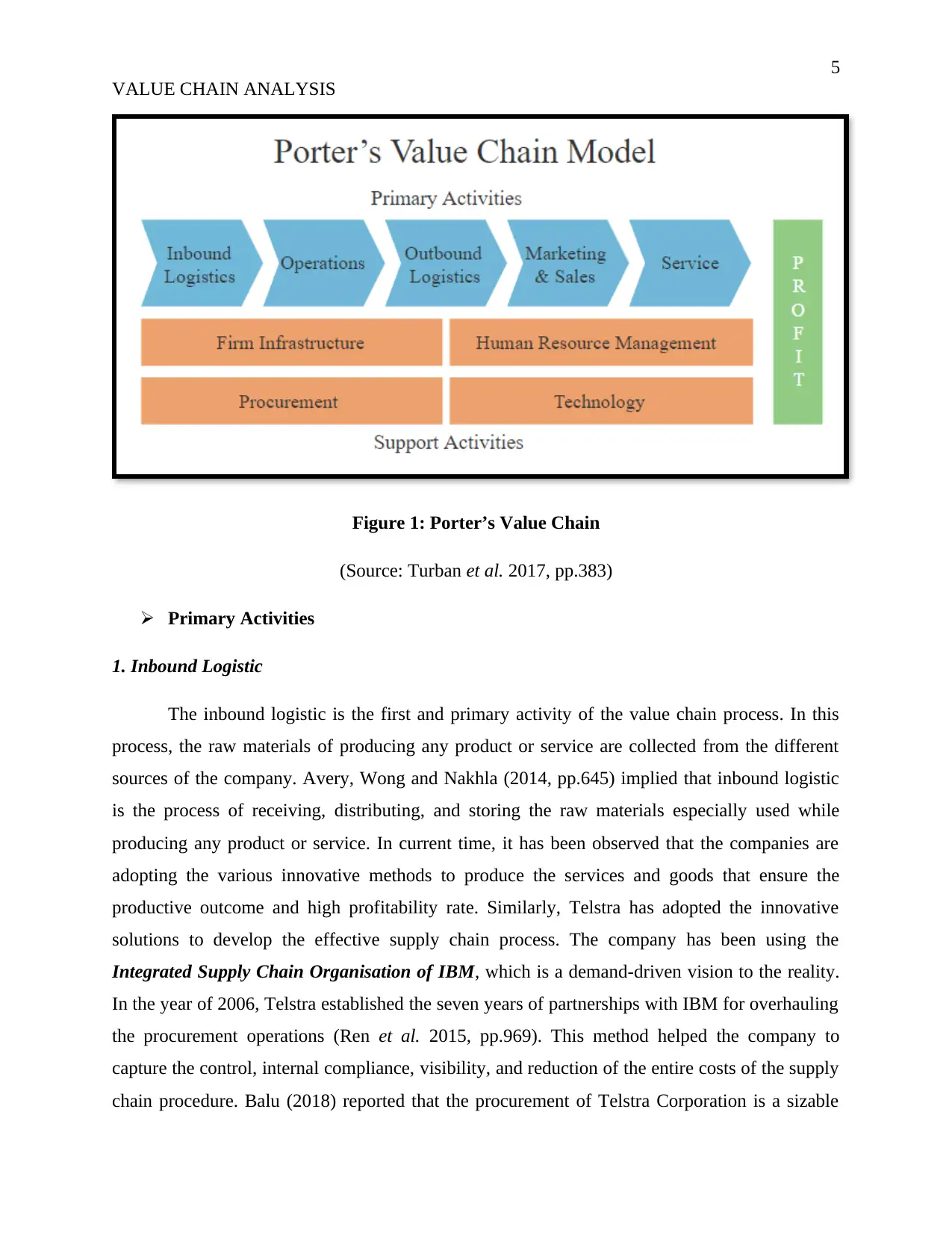
5
VALUE CHAIN ANALYSIS
Figure 1: Porter’s Value Chain
(Source: Turban et al. 2017, pp.383)
Primary Activities
1. Inbound Logistic
The inbound logistic is the first and primary activity of the value chain process. In this
process, the raw materials of producing any product or service are collected from the different
sources of the company. Avery, Wong and Nakhla (2014, pp.645) implied that inbound logistic
is the process of receiving, distributing, and storing the raw materials especially used while
producing any product or service. In current time, it has been observed that the companies are
adopting the various innovative methods to produce the services and goods that ensure the
productive outcome and high profitability rate. Similarly, Telstra has adopted the innovative
solutions to develop the effective supply chain process. The company has been using the
Integrated Supply Chain Organisation of IBM, which is a demand-driven vision to the reality.
In the year of 2006, Telstra established the seven years of partnerships with IBM for overhauling
the procurement operations (Ren et al. 2015, pp.969). This method helped the company to
capture the control, internal compliance, visibility, and reduction of the entire costs of the supply
chain procedure. Balu (2018) reported that the procurement of Telstra Corporation is a sizable
VALUE CHAIN ANALYSIS
Figure 1: Porter’s Value Chain
(Source: Turban et al. 2017, pp.383)
Primary Activities
1. Inbound Logistic
The inbound logistic is the first and primary activity of the value chain process. In this
process, the raw materials of producing any product or service are collected from the different
sources of the company. Avery, Wong and Nakhla (2014, pp.645) implied that inbound logistic
is the process of receiving, distributing, and storing the raw materials especially used while
producing any product or service. In current time, it has been observed that the companies are
adopting the various innovative methods to produce the services and goods that ensure the
productive outcome and high profitability rate. Similarly, Telstra has adopted the innovative
solutions to develop the effective supply chain process. The company has been using the
Integrated Supply Chain Organisation of IBM, which is a demand-driven vision to the reality.
In the year of 2006, Telstra established the seven years of partnerships with IBM for overhauling
the procurement operations (Ren et al. 2015, pp.969). This method helped the company to
capture the control, internal compliance, visibility, and reduction of the entire costs of the supply
chain procedure. Balu (2018) reported that the procurement of Telstra Corporation is a sizable
⊘ This is a preview!⊘
Do you want full access?
Subscribe today to unlock all pages.

Trusted by 1+ million students worldwide
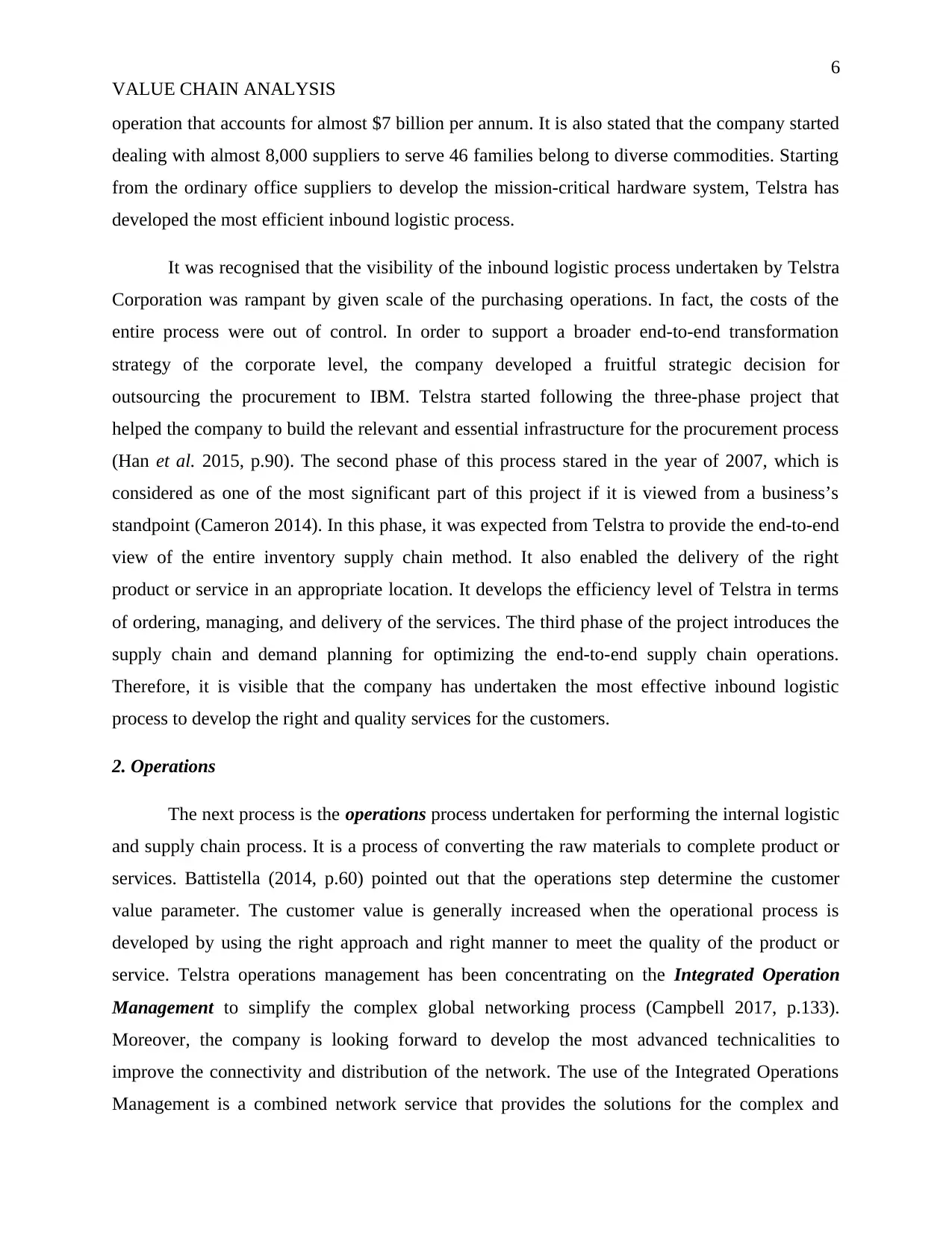
6
VALUE CHAIN ANALYSIS
operation that accounts for almost $7 billion per annum. It is also stated that the company started
dealing with almost 8,000 suppliers to serve 46 families belong to diverse commodities. Starting
from the ordinary office suppliers to develop the mission-critical hardware system, Telstra has
developed the most efficient inbound logistic process.
It was recognised that the visibility of the inbound logistic process undertaken by Telstra
Corporation was rampant by given scale of the purchasing operations. In fact, the costs of the
entire process were out of control. In order to support a broader end-to-end transformation
strategy of the corporate level, the company developed a fruitful strategic decision for
outsourcing the procurement to IBM. Telstra started following the three-phase project that
helped the company to build the relevant and essential infrastructure for the procurement process
(Han et al. 2015, p.90). The second phase of this process stared in the year of 2007, which is
considered as one of the most significant part of this project if it is viewed from a business’s
standpoint (Cameron 2014). In this phase, it was expected from Telstra to provide the end-to-end
view of the entire inventory supply chain method. It also enabled the delivery of the right
product or service in an appropriate location. It develops the efficiency level of Telstra in terms
of ordering, managing, and delivery of the services. The third phase of the project introduces the
supply chain and demand planning for optimizing the end-to-end supply chain operations.
Therefore, it is visible that the company has undertaken the most effective inbound logistic
process to develop the right and quality services for the customers.
2. Operations
The next process is the operations process undertaken for performing the internal logistic
and supply chain process. It is a process of converting the raw materials to complete product or
services. Battistella (2014, p.60) pointed out that the operations step determine the customer
value parameter. The customer value is generally increased when the operational process is
developed by using the right approach and right manner to meet the quality of the product or
service. Telstra operations management has been concentrating on the Integrated Operation
Management to simplify the complex global networking process (Campbell 2017, p.133).
Moreover, the company is looking forward to develop the most advanced technicalities to
improve the connectivity and distribution of the network. The use of the Integrated Operations
Management is a combined network service that provides the solutions for the complex and
VALUE CHAIN ANALYSIS
operation that accounts for almost $7 billion per annum. It is also stated that the company started
dealing with almost 8,000 suppliers to serve 46 families belong to diverse commodities. Starting
from the ordinary office suppliers to develop the mission-critical hardware system, Telstra has
developed the most efficient inbound logistic process.
It was recognised that the visibility of the inbound logistic process undertaken by Telstra
Corporation was rampant by given scale of the purchasing operations. In fact, the costs of the
entire process were out of control. In order to support a broader end-to-end transformation
strategy of the corporate level, the company developed a fruitful strategic decision for
outsourcing the procurement to IBM. Telstra started following the three-phase project that
helped the company to build the relevant and essential infrastructure for the procurement process
(Han et al. 2015, p.90). The second phase of this process stared in the year of 2007, which is
considered as one of the most significant part of this project if it is viewed from a business’s
standpoint (Cameron 2014). In this phase, it was expected from Telstra to provide the end-to-end
view of the entire inventory supply chain method. It also enabled the delivery of the right
product or service in an appropriate location. It develops the efficiency level of Telstra in terms
of ordering, managing, and delivery of the services. The third phase of the project introduces the
supply chain and demand planning for optimizing the end-to-end supply chain operations.
Therefore, it is visible that the company has undertaken the most effective inbound logistic
process to develop the right and quality services for the customers.
2. Operations
The next process is the operations process undertaken for performing the internal logistic
and supply chain process. It is a process of converting the raw materials to complete product or
services. Battistella (2014, p.60) pointed out that the operations step determine the customer
value parameter. The customer value is generally increased when the operational process is
developed by using the right approach and right manner to meet the quality of the product or
service. Telstra operations management has been concentrating on the Integrated Operation
Management to simplify the complex global networking process (Campbell 2017, p.133).
Moreover, the company is looking forward to develop the most advanced technicalities to
improve the connectivity and distribution of the network. The use of the Integrated Operations
Management is a combined network service that provides the solutions for the complex and
Paraphrase This Document
Need a fresh take? Get an instant paraphrase of this document with our AI Paraphraser
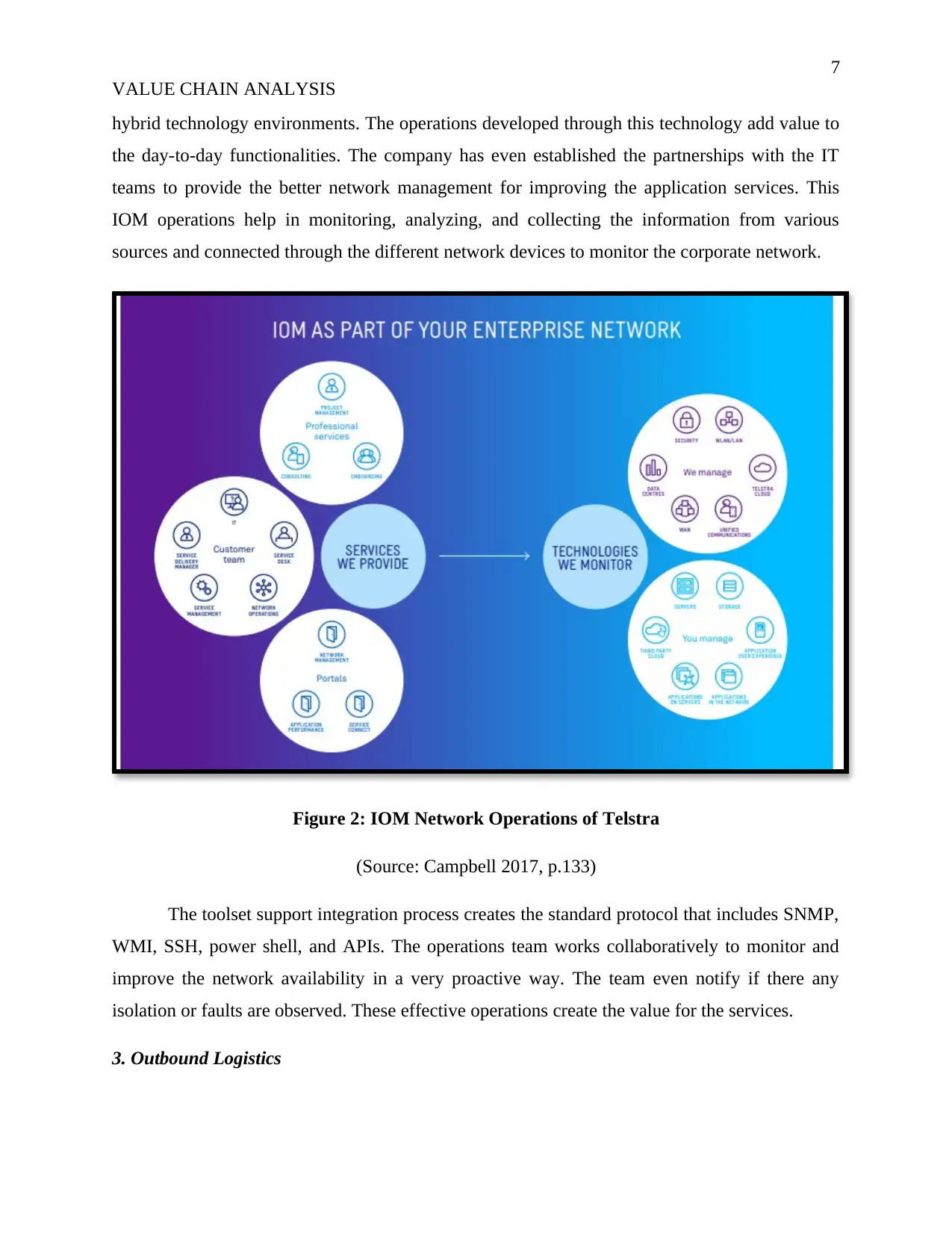
7
VALUE CHAIN ANALYSIS
hybrid technology environments. The operations developed through this technology add value to
the day-to-day functionalities. The company has even established the partnerships with the IT
teams to provide the better network management for improving the application services. This
IOM operations help in monitoring, analyzing, and collecting the information from various
sources and connected through the different network devices to monitor the corporate network.
Figure 2: IOM Network Operations of Telstra
(Source: Campbell 2017, p.133)
The toolset support integration process creates the standard protocol that includes SNMP,
WMI, SSH, power shell, and APIs. The operations team works collaboratively to monitor and
improve the network availability in a very proactive way. The team even notify if there any
isolation or faults are observed. These effective operations create the value for the services.
3. Outbound Logistics
VALUE CHAIN ANALYSIS
hybrid technology environments. The operations developed through this technology add value to
the day-to-day functionalities. The company has even established the partnerships with the IT
teams to provide the better network management for improving the application services. This
IOM operations help in monitoring, analyzing, and collecting the information from various
sources and connected through the different network devices to monitor the corporate network.
Figure 2: IOM Network Operations of Telstra
(Source: Campbell 2017, p.133)
The toolset support integration process creates the standard protocol that includes SNMP,
WMI, SSH, power shell, and APIs. The operations team works collaboratively to monitor and
improve the network availability in a very proactive way. The team even notify if there any
isolation or faults are observed. These effective operations create the value for the services.
3. Outbound Logistics
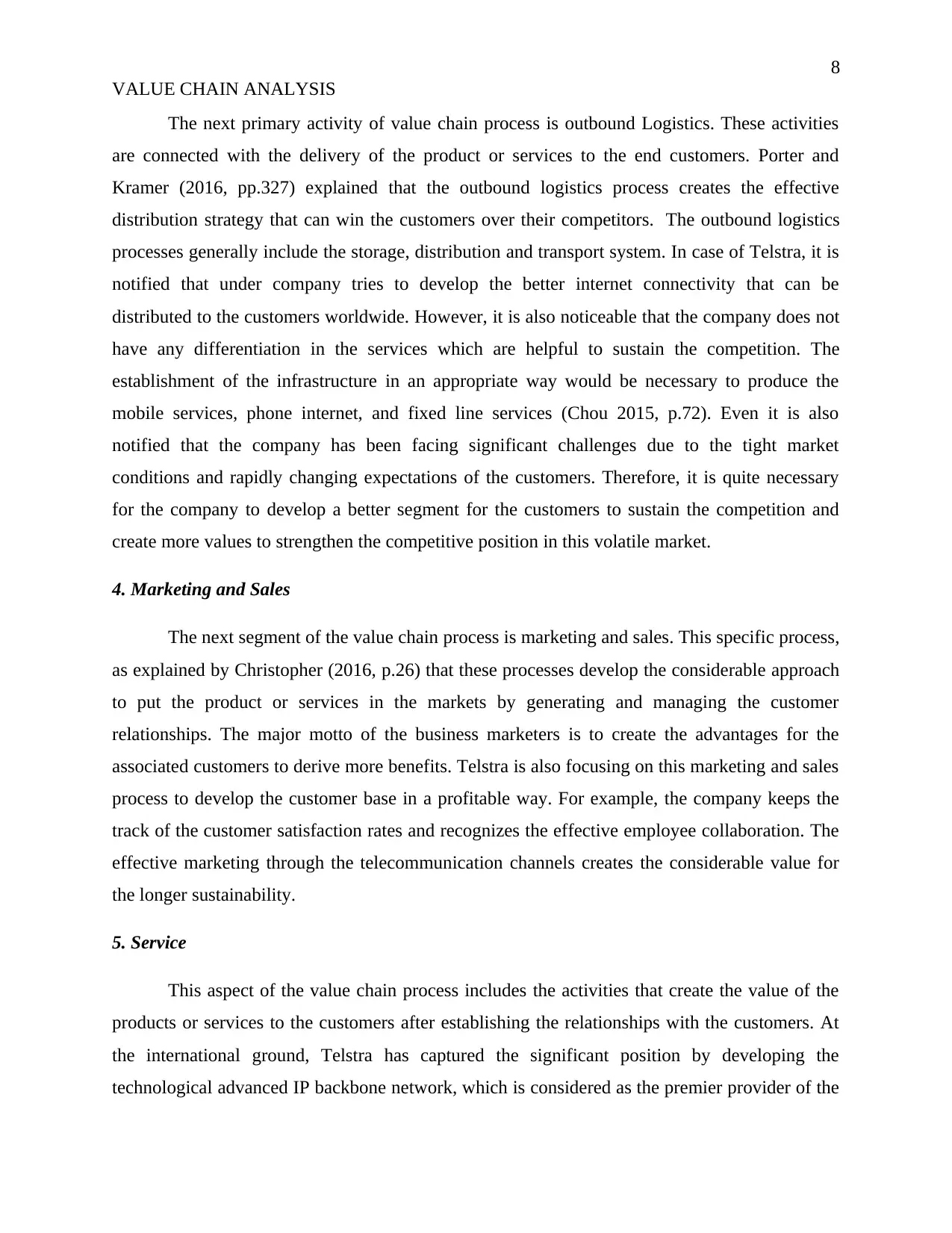
8
VALUE CHAIN ANALYSIS
The next primary activity of value chain process is outbound Logistics. These activities
are connected with the delivery of the product or services to the end customers. Porter and
Kramer (2016, pp.327) explained that the outbound logistics process creates the effective
distribution strategy that can win the customers over their competitors. The outbound logistics
processes generally include the storage, distribution and transport system. In case of Telstra, it is
notified that under company tries to develop the better internet connectivity that can be
distributed to the customers worldwide. However, it is also noticeable that the company does not
have any differentiation in the services which are helpful to sustain the competition. The
establishment of the infrastructure in an appropriate way would be necessary to produce the
mobile services, phone internet, and fixed line services (Chou 2015, p.72). Even it is also
notified that the company has been facing significant challenges due to the tight market
conditions and rapidly changing expectations of the customers. Therefore, it is quite necessary
for the company to develop a better segment for the customers to sustain the competition and
create more values to strengthen the competitive position in this volatile market.
4. Marketing and Sales
The next segment of the value chain process is marketing and sales. This specific process,
as explained by Christopher (2016, p.26) that these processes develop the considerable approach
to put the product or services in the markets by generating and managing the customer
relationships. The major motto of the business marketers is to create the advantages for the
associated customers to derive more benefits. Telstra is also focusing on this marketing and sales
process to develop the customer base in a profitable way. For example, the company keeps the
track of the customer satisfaction rates and recognizes the effective employee collaboration. The
effective marketing through the telecommunication channels creates the considerable value for
the longer sustainability.
5. Service
This aspect of the value chain process includes the activities that create the value of the
products or services to the customers after establishing the relationships with the customers. At
the international ground, Telstra has captured the significant position by developing the
technological advanced IP backbone network, which is considered as the premier provider of the
VALUE CHAIN ANALYSIS
The next primary activity of value chain process is outbound Logistics. These activities
are connected with the delivery of the product or services to the end customers. Porter and
Kramer (2016, pp.327) explained that the outbound logistics process creates the effective
distribution strategy that can win the customers over their competitors. The outbound logistics
processes generally include the storage, distribution and transport system. In case of Telstra, it is
notified that under company tries to develop the better internet connectivity that can be
distributed to the customers worldwide. However, it is also noticeable that the company does not
have any differentiation in the services which are helpful to sustain the competition. The
establishment of the infrastructure in an appropriate way would be necessary to produce the
mobile services, phone internet, and fixed line services (Chou 2015, p.72). Even it is also
notified that the company has been facing significant challenges due to the tight market
conditions and rapidly changing expectations of the customers. Therefore, it is quite necessary
for the company to develop a better segment for the customers to sustain the competition and
create more values to strengthen the competitive position in this volatile market.
4. Marketing and Sales
The next segment of the value chain process is marketing and sales. This specific process,
as explained by Christopher (2016, p.26) that these processes develop the considerable approach
to put the product or services in the markets by generating and managing the customer
relationships. The major motto of the business marketers is to create the advantages for the
associated customers to derive more benefits. Telstra is also focusing on this marketing and sales
process to develop the customer base in a profitable way. For example, the company keeps the
track of the customer satisfaction rates and recognizes the effective employee collaboration. The
effective marketing through the telecommunication channels creates the considerable value for
the longer sustainability.
5. Service
This aspect of the value chain process includes the activities that create the value of the
products or services to the customers after establishing the relationships with the customers. At
the international ground, Telstra has captured the significant position by developing the
technological advanced IP backbone network, which is considered as the premier provider of the
⊘ This is a preview!⊘
Do you want full access?
Subscribe today to unlock all pages.

Trusted by 1+ million students worldwide
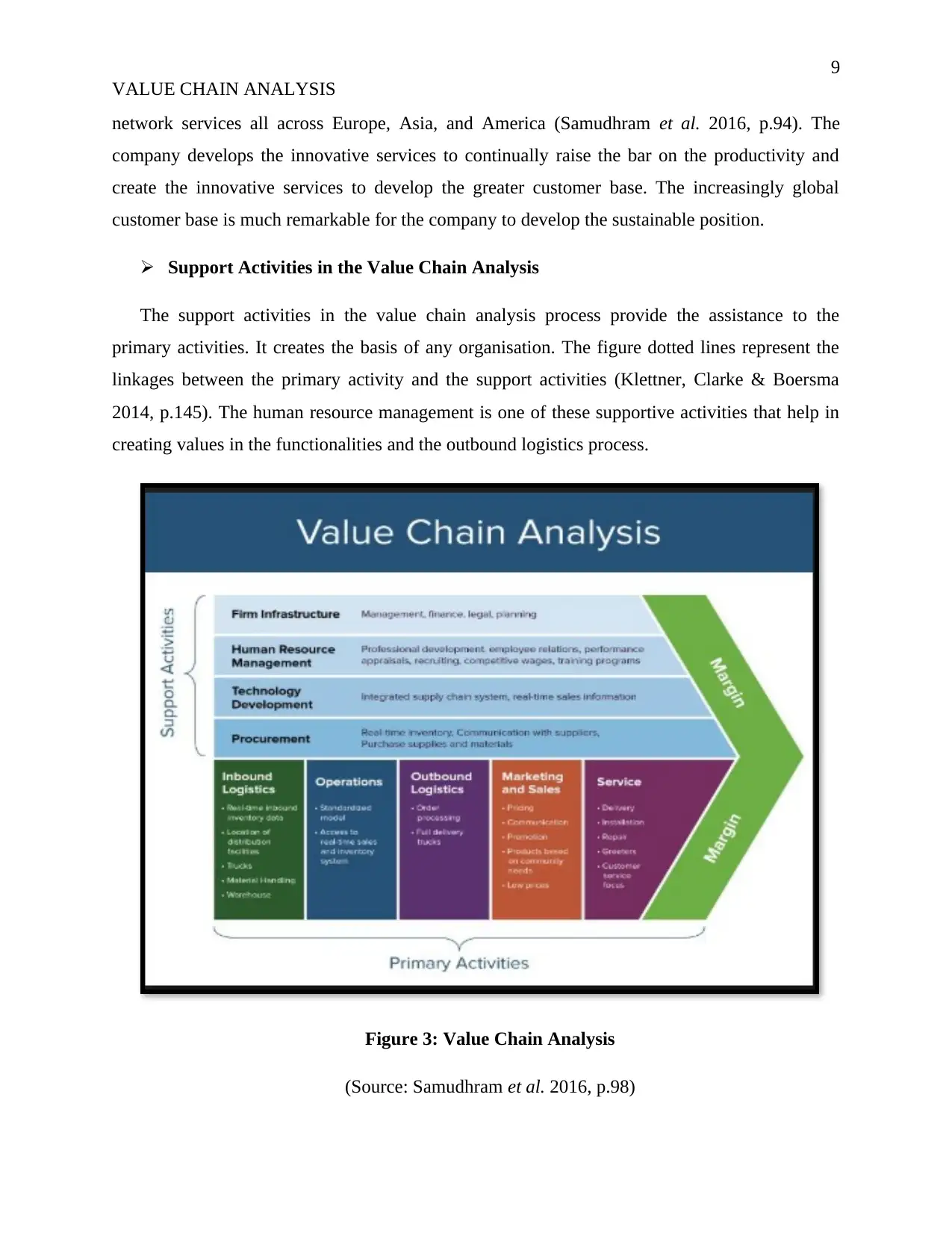
9
VALUE CHAIN ANALYSIS
network services all across Europe, Asia, and America (Samudhram et al. 2016, p.94). The
company develops the innovative services to continually raise the bar on the productivity and
create the innovative services to develop the greater customer base. The increasingly global
customer base is much remarkable for the company to develop the sustainable position.
Support Activities in the Value Chain Analysis
The support activities in the value chain analysis process provide the assistance to the
primary activities. It creates the basis of any organisation. The figure dotted lines represent the
linkages between the primary activity and the support activities (Klettner, Clarke & Boersma
2014, p.145). The human resource management is one of these supportive activities that help in
creating values in the functionalities and the outbound logistics process.
Figure 3: Value Chain Analysis
(Source: Samudhram et al. 2016, p.98)
VALUE CHAIN ANALYSIS
network services all across Europe, Asia, and America (Samudhram et al. 2016, p.94). The
company develops the innovative services to continually raise the bar on the productivity and
create the innovative services to develop the greater customer base. The increasingly global
customer base is much remarkable for the company to develop the sustainable position.
Support Activities in the Value Chain Analysis
The support activities in the value chain analysis process provide the assistance to the
primary activities. It creates the basis of any organisation. The figure dotted lines represent the
linkages between the primary activity and the support activities (Klettner, Clarke & Boersma
2014, p.145). The human resource management is one of these supportive activities that help in
creating values in the functionalities and the outbound logistics process.
Figure 3: Value Chain Analysis
(Source: Samudhram et al. 2016, p.98)
Paraphrase This Document
Need a fresh take? Get an instant paraphrase of this document with our AI Paraphraser
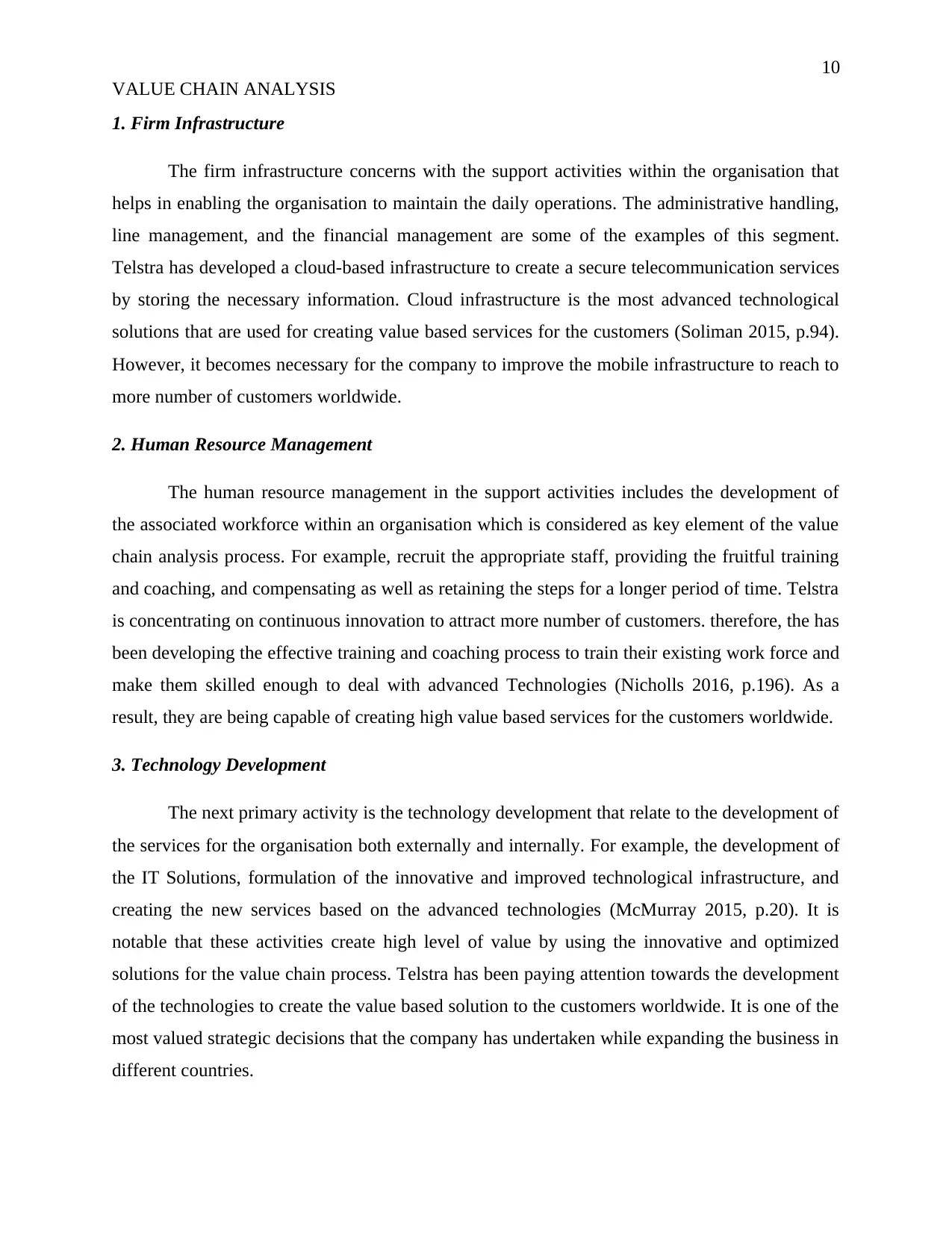
10
VALUE CHAIN ANALYSIS
1. Firm Infrastructure
The firm infrastructure concerns with the support activities within the organisation that
helps in enabling the organisation to maintain the daily operations. The administrative handling,
line management, and the financial management are some of the examples of this segment.
Telstra has developed a cloud-based infrastructure to create a secure telecommunication services
by storing the necessary information. Cloud infrastructure is the most advanced technological
solutions that are used for creating value based services for the customers (Soliman 2015, p.94).
However, it becomes necessary for the company to improve the mobile infrastructure to reach to
more number of customers worldwide.
2. Human Resource Management
The human resource management in the support activities includes the development of
the associated workforce within an organisation which is considered as key element of the value
chain analysis process. For example, recruit the appropriate staff, providing the fruitful training
and coaching, and compensating as well as retaining the steps for a longer period of time. Telstra
is concentrating on continuous innovation to attract more number of customers. therefore, the has
been developing the effective training and coaching process to train their existing work force and
make them skilled enough to deal with advanced Technologies (Nicholls 2016, p.196). As a
result, they are being capable of creating high value based services for the customers worldwide.
3. Technology Development
The next primary activity is the technology development that relate to the development of
the services for the organisation both externally and internally. For example, the development of
the IT Solutions, formulation of the innovative and improved technological infrastructure, and
creating the new services based on the advanced technologies (McMurray 2015, p.20). It is
notable that these activities create high level of value by using the innovative and optimized
solutions for the value chain process. Telstra has been paying attention towards the development
of the technologies to create the value based solution to the customers worldwide. It is one of the
most valued strategic decisions that the company has undertaken while expanding the business in
different countries.
VALUE CHAIN ANALYSIS
1. Firm Infrastructure
The firm infrastructure concerns with the support activities within the organisation that
helps in enabling the organisation to maintain the daily operations. The administrative handling,
line management, and the financial management are some of the examples of this segment.
Telstra has developed a cloud-based infrastructure to create a secure telecommunication services
by storing the necessary information. Cloud infrastructure is the most advanced technological
solutions that are used for creating value based services for the customers (Soliman 2015, p.94).
However, it becomes necessary for the company to improve the mobile infrastructure to reach to
more number of customers worldwide.
2. Human Resource Management
The human resource management in the support activities includes the development of
the associated workforce within an organisation which is considered as key element of the value
chain analysis process. For example, recruit the appropriate staff, providing the fruitful training
and coaching, and compensating as well as retaining the steps for a longer period of time. Telstra
is concentrating on continuous innovation to attract more number of customers. therefore, the has
been developing the effective training and coaching process to train their existing work force and
make them skilled enough to deal with advanced Technologies (Nicholls 2016, p.196). As a
result, they are being capable of creating high value based services for the customers worldwide.
3. Technology Development
The next primary activity is the technology development that relate to the development of
the services for the organisation both externally and internally. For example, the development of
the IT Solutions, formulation of the innovative and improved technological infrastructure, and
creating the new services based on the advanced technologies (McMurray 2015, p.20). It is
notable that these activities create high level of value by using the innovative and optimized
solutions for the value chain process. Telstra has been paying attention towards the development
of the technologies to create the value based solution to the customers worldwide. It is one of the
most valued strategic decisions that the company has undertaken while expanding the business in
different countries.
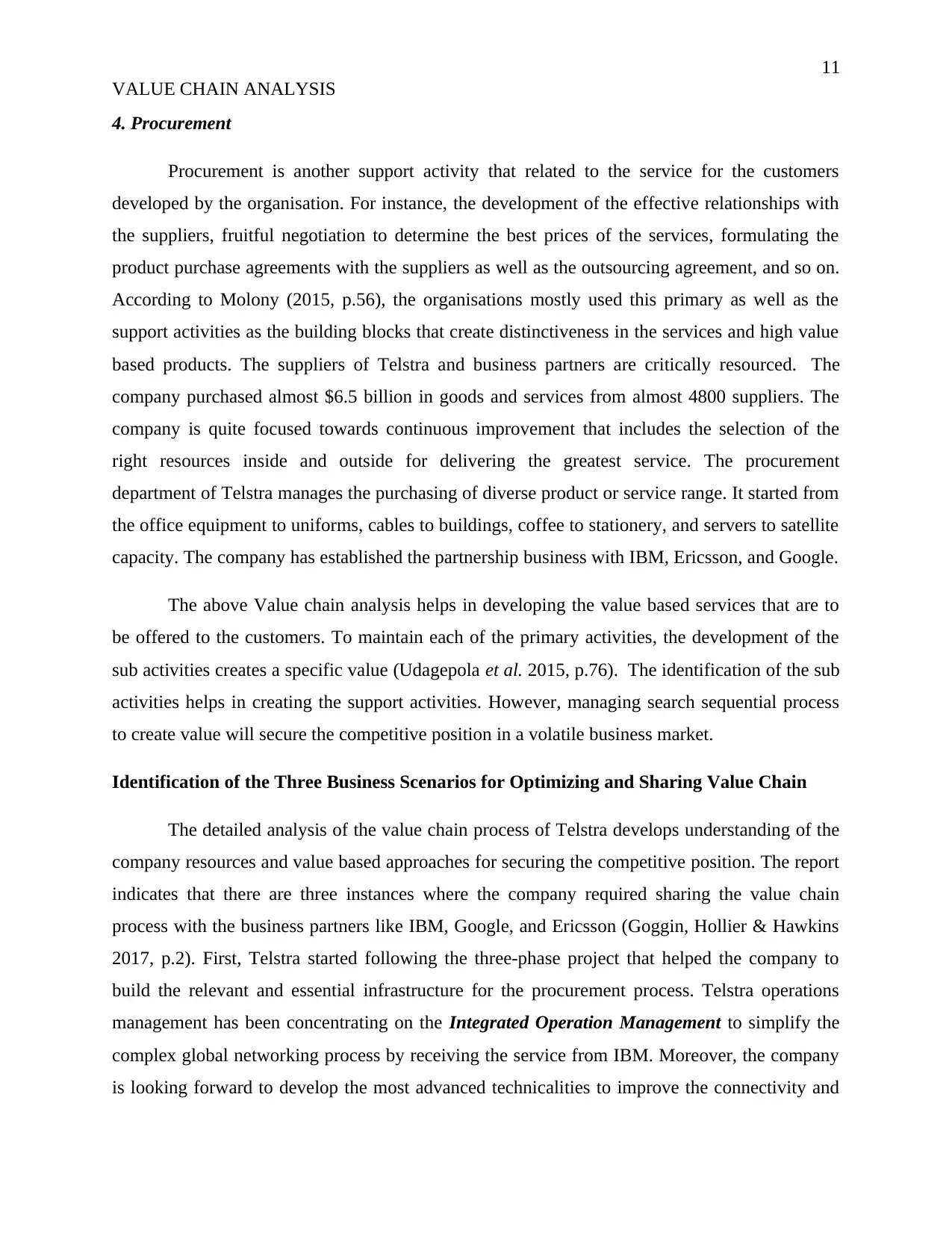
11
VALUE CHAIN ANALYSIS
4. Procurement
Procurement is another support activity that related to the service for the customers
developed by the organisation. For instance, the development of the effective relationships with
the suppliers, fruitful negotiation to determine the best prices of the services, formulating the
product purchase agreements with the suppliers as well as the outsourcing agreement, and so on.
According to Molony (2015, p.56), the organisations mostly used this primary as well as the
support activities as the building blocks that create distinctiveness in the services and high value
based products. The suppliers of Telstra and business partners are critically resourced. The
company purchased almost $6.5 billion in goods and services from almost 4800 suppliers. The
company is quite focused towards continuous improvement that includes the selection of the
right resources inside and outside for delivering the greatest service. The procurement
department of Telstra manages the purchasing of diverse product or service range. It started from
the office equipment to uniforms, cables to buildings, coffee to stationery, and servers to satellite
capacity. The company has established the partnership business with IBM, Ericsson, and Google.
The above Value chain analysis helps in developing the value based services that are to
be offered to the customers. To maintain each of the primary activities, the development of the
sub activities creates a specific value (Udagepola et al. 2015, p.76). The identification of the sub
activities helps in creating the support activities. However, managing search sequential process
to create value will secure the competitive position in a volatile business market.
Identification of the Three Business Scenarios for Optimizing and Sharing Value Chain
The detailed analysis of the value chain process of Telstra develops understanding of the
company resources and value based approaches for securing the competitive position. The report
indicates that there are three instances where the company required sharing the value chain
process with the business partners like IBM, Google, and Ericsson (Goggin, Hollier & Hawkins
2017, p.2). First, Telstra started following the three-phase project that helped the company to
build the relevant and essential infrastructure for the procurement process. Telstra operations
management has been concentrating on the Integrated Operation Management to simplify the
complex global networking process by receiving the service from IBM. Moreover, the company
is looking forward to develop the most advanced technicalities to improve the connectivity and
VALUE CHAIN ANALYSIS
4. Procurement
Procurement is another support activity that related to the service for the customers
developed by the organisation. For instance, the development of the effective relationships with
the suppliers, fruitful negotiation to determine the best prices of the services, formulating the
product purchase agreements with the suppliers as well as the outsourcing agreement, and so on.
According to Molony (2015, p.56), the organisations mostly used this primary as well as the
support activities as the building blocks that create distinctiveness in the services and high value
based products. The suppliers of Telstra and business partners are critically resourced. The
company purchased almost $6.5 billion in goods and services from almost 4800 suppliers. The
company is quite focused towards continuous improvement that includes the selection of the
right resources inside and outside for delivering the greatest service. The procurement
department of Telstra manages the purchasing of diverse product or service range. It started from
the office equipment to uniforms, cables to buildings, coffee to stationery, and servers to satellite
capacity. The company has established the partnership business with IBM, Ericsson, and Google.
The above Value chain analysis helps in developing the value based services that are to
be offered to the customers. To maintain each of the primary activities, the development of the
sub activities creates a specific value (Udagepola et al. 2015, p.76). The identification of the sub
activities helps in creating the support activities. However, managing search sequential process
to create value will secure the competitive position in a volatile business market.
Identification of the Three Business Scenarios for Optimizing and Sharing Value Chain
The detailed analysis of the value chain process of Telstra develops understanding of the
company resources and value based approaches for securing the competitive position. The report
indicates that there are three instances where the company required sharing the value chain
process with the business partners like IBM, Google, and Ericsson (Goggin, Hollier & Hawkins
2017, p.2). First, Telstra started following the three-phase project that helped the company to
build the relevant and essential infrastructure for the procurement process. Telstra operations
management has been concentrating on the Integrated Operation Management to simplify the
complex global networking process by receiving the service from IBM. Moreover, the company
is looking forward to develop the most advanced technicalities to improve the connectivity and
⊘ This is a preview!⊘
Do you want full access?
Subscribe today to unlock all pages.

Trusted by 1+ million students worldwide
1 out of 18
Related Documents
Your All-in-One AI-Powered Toolkit for Academic Success.
+13062052269
info@desklib.com
Available 24*7 on WhatsApp / Email
![[object Object]](/_next/static/media/star-bottom.7253800d.svg)
Unlock your academic potential
Copyright © 2020–2025 A2Z Services. All Rights Reserved. Developed and managed by ZUCOL.




